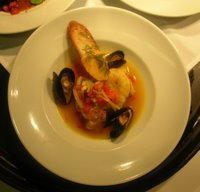FISH STEW
 Tonight's fish dish is Fish Stew, Marseille-Style. Fish stew? Hmm, I'm not sold. The recipe says that the dish consists of sea bass, red snapper, shrimp and the always-ugly monkfish.
Tonight's fish dish is Fish Stew, Marseille-Style. Fish stew? Hmm, I'm not sold. The recipe says that the dish consists of sea bass, red snapper, shrimp and the always-ugly monkfish.More after class on the jump...
DISH: Fish Stew Marseilles-Style, Bouillabaisse à La Marseillaise
RECIPE:
The Fish & Stew
1 KG Sea Bass, Scaled and Gutted
1 KG Red Snapper, Scaled and Butted
2 KG Monkfish
500 G Shrimp
120 ML Olive Oil
250 ML Ricard
4 Pinches Saffron, Crushed Between Fingertips
8 Garlic Cloves, Green Germ Removed, Cloves Sliced Thin
500 G Tomatoes, Mondées and Hachées
1 KG Mussels
2 Large Onions, Ciselés
4 Medium Leeks, Cut Julienne
4 Garlic Cloves, Smashed
2 Fennel Bulbs, Julienne
1 Conger Eel, Skinned and Deboned, Optional
50 G Tomato Paste
20 G Thyme, Chopped
4 L Fish Stock
10 G Grated Orange Rind
Salt & Freshly Ground Black Pepper
The Rouille
4 Garlic Cloves
1 Slice Firm White Bread
50 G Cooked Potatoes, Peeled
60 ML Fish or Vegetable Stock
1 Egg Yolk
Cayenne Pepper
Paprika
1 Pinch of Saffron
Salt
80 ML Blended Olive Oil
The Croutons
¼ Baguette, Cut Into ¼-inch Slices, A 16 Slices
20 ML Blended Olive Oil
The Garnish
Fennel or Dill Fronds
Procedure:
FISH & STEW Fillet the sea bass, snapper, and monkfish. Trim the monkfish and shell the shrimp. Clean the fish bones and reserve along with the shells from the shrimp. Cut the sea bass, snapper, and monkfish into 30- to 40-gram pieces. Marinate the fish with half of hte olive oil, the Ricard, saffron, sliced garlic, and 100 G of the tomatoes. Steam open the mussels. When open, remove any beard in the center, and then remove the mussels from the shell. Reserve the mussels in their cooking liquor. Heat the olive oil in a saucepot. When hot, add the onion, leek, and garlic, and cook for 2 to 3 minutes. Add the fennel, the remaining tomatoes, the optional eel, the tomato paste, and the chopped herbs. Cook over low heat for 5 minutes. Add 2 L of fumet to the vegetables. Bring to a boil, lower to a simmer, and cook for 15 minutes. Mix the grated orange rind and the crusted saffron in 100 ML of fish fumet. Add this to the vegetable/fish stock. Bring to a boil, add salt and pepper, and set aside off heat until service. Remove conger eel if any was used.
ROUILLE Place the garlic and the bread in the bowl of the food processor and process until finely chopped. Add the cooked potatoes and process until smooth. Add the fish or vegetable stock (you don't have to strain it). Process the mixture until smooth and add the egg yolk and seasonings. With the motor running, add the oil in a thin but steady stream. Taste and adjust the seasonings, remove the rouille to a bowl, and keep at room temperature until service.
CROUTONS Spread the oil on a half-sheet pan and arrange the slices of bread on top, pressing a little so they absorb the oil. Turn them over. Bake at 400ºF for 1 to 2 minutes. They should be browned on both sides.
GARNISH & TO ORDER A little before service, bring the vegetable stock to a boil. Add to a sautoir enough fish for the number of covers being prepared. Add enough stock to just cover the fish. Bring the mixture to a boil and add the shrump. Lower the heat to simmer and cook for 2 to 3 minutes. Add 3 clean mussels to the bottom of a warm soup bowl. Ladle over the stock and a portion of the fish. Be sure to have an appropriate ratio of fish, begetables, and stock in each bowl. To serve: Spread rouille on the croutons, allowing 4 per person, and top with fennel or a dill frong. Place one crouton in the center of the bowl and serve the rest on the side.
Note: If the specific fish called for in the recipe are not available, use what is fresh and in season. If you add a little Ricard, olive oil, and garlic to the fish and marinate it for 1 hour, the flavor of the bouillabaisse will more closely resemble that of a Marseilles.
BREAKDOWN: The first thing to know about being back up at the Fish and Meat Stations (Poissonier and Saucier) is that Chef M., goes over the recipes for about 15 minutes after roll call. It's valuable, of course, but it also means that with class starting at 5:45 p.m. (we usally get there early and start our mise en place beforehand to get a jump on things) we usually don't get going on the recipes until about 6:10 p.m. That means you have to move quickly. With as many people as we have now (5 generally) and our skill levels improved, we're usually fine with a little less time (in fact we're never really "in the weeds" during service because we have so many people per group (almost too many!). I've been told that Chef M. is one of the best in the school, and while I'm not going to comment on that either way, I will say that he often changes our recipes significantly from how they're printed in the book. During Level Two this meant more things to remember for the midterm-- and it will mean more things to remember for the final as well.
In this case, there weren't that many things that were changed in the original recipe. One thing we didn't do was to add the conger eel that the recipe noted was optional. The ingredients above were multiplied 5X for restaurant service, we baked the potatoes in the oven for 40 minutes at about 375°F. Instead of doing a julienne of the fennel bulbs used in the stew as per the recipe, we peeled off the outer layer, cut them in half lengthwise and then just cut the halves thinly. Once they were sweat in butter they were lay out on top of the other vegetables on a sheet pan.
 The end result was a rather attractive dish. I say rather because while I love fish, for one reason or another I'm often skeptical about how it's going to taste when I read the recipe or see other groups' presentations. It's not that they don't sound or look good necessarily but I think the Level Two fish dishes including the skate grenobloise and the marguery put me off trusting without a doubt that the fish dishes in our recipe books are going to taste good. While fish with cream sauce has grown on me I'm still not a Skate fan. Isn't it more of a shark than a fish anyway? Isn't it on an endangered species list? No? Can't we get it on that list somewhow--it's slimy and it doesn't taste that good anyway.
The end result was a rather attractive dish. I say rather because while I love fish, for one reason or another I'm often skeptical about how it's going to taste when I read the recipe or see other groups' presentations. It's not that they don't sound or look good necessarily but I think the Level Two fish dishes including the skate grenobloise and the marguery put me off trusting without a doubt that the fish dishes in our recipe books are going to taste good. While fish with cream sauce has grown on me I'm still not a Skate fan. Isn't it more of a shark than a fish anyway? Isn't it on an endangered species list? No? Can't we get it on that list somewhow--it's slimy and it doesn't taste that good anyway.This dish was actually pretty good. We had to make sure the fish was cooked all the way through though. Raw monkfish isn't something I'd like to eat or serve. We stacked the fish and shrimp for one order in a pile with the vegetables on top and brought it to a boil in a sautoir on the stovetop and then put it in a preheated oven for another 2-3 minutes before plating it.
Chef M. showed us an improvement on the dish, mixing the rouille with the broth separately and pouring some of it in each dish. This adds some more substance to the broth and makes it more of a full-bodied stew than it was otherwise. With the Ricard and without this alteration the dish was very much dominated by a fennel/anise/liquorice taste.
One thing, with quite a bit of prep work and filleting, this dish would seem to be somewhat of a nightmare for a final exam.





0 Comments:
Post a Comment
<< Home